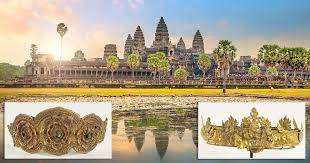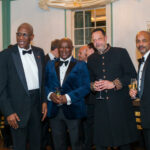
It has been revealed that an enormous hoard of treasure that resurfaced in London in 2022, was in fact part of the crown jewels of Cambodia’s former Hindu-Buddhist Angkorian empire, with some items dating right the way back to the 7th century.
It transpired that they were stolen pieces which had been in the hands of a pre-eminent collector of that country’s antiquities by the name of Douglas Latchford, but he turned out to be nothing more than an untrustworthy and dishonest art smuggler, who would die at his home in Bangkok in 2020, aged 88, ahead of a trial in the United States, after being indicted by American prosecutors, on a charge of Cambodian antiquities trafficking.
Excited experts were stunned when learning of the jewellery’s existence, stating that most of it had never been seen before, and much of it can be matched to stone carvings in the walls of UNESCO World Heritage Site, Angkor Wat.
The Cambodian authorities are convinced that there is still more to be found, but for now the collection has been secretly returned to the capital city, Phnom Penh, and is due to go on display there in the country’s national museum.
Seventh century crown
After Latchford’s death his family promised to return all of the stolen collection to Cambodia, but at that time the authorities did not know exactly what would be handed over, or indeed how exactly it would happen. Nobody was quite expecting what came back; there were 77 pieces of gold and jewel-encrusted jewellery, including crowns, belts and earrings.
There was also a large bowl which experts date as far back as the 11th Century and believe it could have been used as a rice bowl for Angkorian royalty. Their early thoughts are it is made of solid gold. One of the crowns appears to be from even further back, before the Angkorian period, with estimates put at the 7th Century.
Ancient crown jewels in corner of a car park
It is still unclear how and when the jewellery was stolen, or how the haul made its way to London.
The head of an investigation team, Brad Gordon was the first representative to see the collection last summer, when he was driven by one of Latchford’s family to a secret location. In a scene that sounded as if it could have been straight out of a TV drama, he described being taken to a corner of a car park and in a second vehicle he was shown four boxes that incredibly contained the crown jewels of an ancient Cambodian civilization, which at its time was known as the Angkorian Empire.
Angkorian empire
Angkor was the capital city of the Khmer Empire, but became known as the Angkorian Empire, which flourished from around the 9th to the 15th centuries and is the name which historians refer back to from that period of time, for present day Cambodia.
Angkor Wat is one of its main tourist attractions and is the largest religious monument in the world, initially built as a Hindu Temple in the 11th century, although it later became a Buddhist Temple. A high proportion of the items that were in the boxes handed over, have been matched to stone carvings in the walls of Angkor Wat and many believe that looting took place there and in surrounding temples, during the Khmer Rouge era during the seventies, and the pieces could have slipped through then.
Book doubling as a sales brochure
Another of Mr Latchford’s underhand activities involved him creating a book titled Khmer Gold, which has been described by Khmer antiquities expert Ashley Thompson as nothing more than an elaborate sales brochure, to give private collectors a taste of what could be obtained illegally. She says the book is full of what are best explained as half-truths and as such, nothing in it has any safe provenance.
Reformed looter identified pieces
The Cambodians themselves, have evidence from Latchford’s email correspondence that he was attempting to secretly sell the collection from a north London warehouse as late as 2019. They already have statements from a reformed looter by the name of Toek Tik, who has identified 33 pieces as objects that he personally stole and sold on to intermediaries, who worked with Latchford.
It is strongly suspected that many of those items have ended up in highly respected establishments such as the British Museum. Naturally, the Cambodians want everything returned, but for now they are delighted to have the crown jewels back in their rightful home.
Who was Douglas Latchford?
Douglas Arthur Joseph Latchford was born on October 15, 1931, in Mumbai, India; but he was a British citizen and was educated in Brighton. He began in the pharmaceutical trade, moving between Singapore and Bangkok, where he settled from 1956, becoming a Thai citizen in 1968 and taking the Thai name: Pakpong Kriangsak.
Hooked on Khmer art
He was introduced to Khmer art and became hooked, purchasing all many of objects from markets at low cost. He started trading in the art with local and international sellers and gained for himself a reputation as a pre-eminent collector of Cambodian antiquities, and a cultured accumulator of museum-quality Khmer sculptures and jewels.
Cambodia’s knighthood equivalent
Indeed, back in 2008, the Cambodian Government granted him the Grand Cross of the Royal Order of Monisaraphon, which is more or less the equivalent of a knighthood. This was as recognition for him donating money and exhibits to its state museums; little did they know that most of the money had been obtained corruptly and most of the exhibits were stolen goods.
Collaborating with the Met museum
He became closely involved with Martin Lerner, the curator of South and Southeast Asian art at the Metropolitan Museum of Art in New York. Their collaboration, enabled the museum to build a world-class collection. In 1983, Latchford gave the museum 13 premier examples of Khmer sculpture, including the torsos of twin stone statues, the Kneeling Attendants. The sculptures were eventually repatriated to Cambodia in 2013, a full 30 years later, after it was confirmed that they were in actual fact, looted from the Koh Ker temple.
Past starts to catch up
A year earlier things had started to unravel for Latchford when authorities became suspicious that two statutes he had acquired and put on sale Sotheby’s in London, were also looted.
Federal prosecutors finally caught up with him and accused him of trafficking in looted Cambodian relics and falsifying documentation, adding that it was their belief that he had “built a career out of the smuggling and illicit sale of priceless Cambodian antiquities, often straight from archaeological sites.” They argued that Latchford had taken advantage of the upheaval, civil war and genocide that racked Cambodia from the sixties to the nineties.
Family do the right thing
The Latchford family to their credit have always maintained that they would repatriate his $50 million collection of Khmer antiquities to the Cambodians. His daughter said: “I would like everything that Douglas assembled be kept where people around the world can enjoy it and understand it. Despite what people say, my father started his collection in a very different era, and that world has changed.”






0 Comments